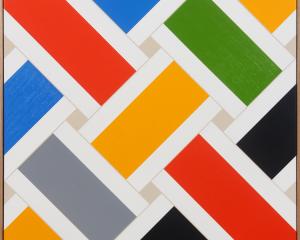In this week's Art Seen, Robyn Maree Pickens looks at exhibitions from Caitlin Clarke, the Dunedin Public Art Gallery, and 165 George Street.
 ‘‘A path in’’, Caitlin Clarke.
''A path in'' Caitlin Clarke (Laurel Projects)
‘‘A path in’’, Caitlin Clarke.
''A path in'' Caitlin Clarke (Laurel Projects)

If you were to take a path which one might you choose? It is a very open ended question. If the path concerned what it means to make art in a time of socio-ecological precarity, then I would follow Caitlin Clarke.
The many paths, processes, and practices evident in Clarke's exhibition embody reciprocity with the rest of nature. Clarke works with found clay, which after the artwork has been exhibited, she returns to its source as a vessel.
In addition to this careful attention to and honouring of whenua and provenance, there is another mode of reciprocity on offer, which involves the organisation Trees That Count, which encourages the distribution and planting of native trees. Visitors are invited to take away a small kowhai seedling from the gallery to plant in their garden.
Clarke has created a contemplative space for slowing down and engaging with chunks of earth that have been hand shaped into a variety of vessels. These vessels are placed on or in relationship to old red bricks that reference both the kiln, and, as Clarke is from ftautahi (Christchurch), cannot quite escape a link to the destruction of the Christchurch earthquakes.
Visitors can sit on pillows with handmade covers to examine the works in detail, or sit and look up at the billowing fabric hanging down in puffs from the ceiling and small coils of clay similarly suspended. Make time to visit.
 Richard Orjis and val smith (Wilde Projects) in Civic Pride, curated by Milly Mitchell-Anyon
''Civic Pride'' curated by Milly Mitchell-Anyon (DPAG)
Richard Orjis and val smith (Wilde Projects) in Civic Pride, curated by Milly Mitchell-Anyon
''Civic Pride'' curated by Milly Mitchell-Anyon (DPAG)

There is a measure of ambivalence embodied in the title of the exhibition ''Civic Pride'' curated by the Dunedin Public Art Gallery's 2019 curatorial intern Milly Mitchell-Anyon.
The ''civic'' of the title is deployed widely to encompass Aotearoa's colonial history - specifically the formation of the Octagon and the planting of plane trees from Kew Garden to prefigure the New Zealand and South Seas Exhibition, 1889 - while the accompanying exhibition text, more so than the exhibition itself, acknowledges the ongoing ramifications of colonisation.
The ''pride'' of the title functions somewhat as a question mark (are we proud of the legacy of colonisation?) while also making specific connections to LGBTQIA Pride.
While there are wide-ranging connections across art genres - from photographs to wood turned bowls to paintings - that are generous and productive, one of the exhibition's strengths is the contribution made by Wilde Projects (Richard Orjis and val smith).
Their contribution functions as a kind of intervention that encourages visitors to consider alternative approaches for living with the rest of nature.
The art making approach, called Bttm Methodology (developed by Orjis and smith), has its roots in queer ecological relations and inter-species connections, and both the installation works, including sandwich boards with ideas, slogans and hashtags that range from manifesto to conversation to open-ended speculation, banner, and voiced meditation accompanying a static black and white projection of the Octagon in 1975 invite visitors to imagine new forms of kinship.
 Hinetitama, by Metiria Turei (2019).
''Tangata Whenua: View from the Shore'' (165 George Street)
Hinetitama, by Metiria Turei (2019).
''Tangata Whenua: View from the Shore'' (165 George Street)

''Tangata Whenua: View from the Shore'' is an important exhibition that contributes an alternative perspective to many of the sanitised, nationwide commemorations collected under the umbrella title Tuia Encounters 250 (250 years since James Cook first encountered tangata whenua in 1769).
''View from the Shore'' is a progressive exhibition, which will change and develop over the remainder of the month as more works are added or enlarged.
The exhibition feels democratic, non-hierarchical, and welcoming. It includes work by established artists like Cath Cocker, Ayesha Green, and Metiria Turei alongside younger and emerging artists like Teah Paterson who work in a range of media including painting, photography, poetry, installation and projection, fibre arts, and textiles.
The artists address issues like colonisation, settler colonialism, the politics of nation building, racism, stereotypes, the predominantly Maori and Pasifika newborns taken by the children's agency Oranga Tamariki, and what it means to live with all of this: the emotional labour required to endure macro- and micro-aggressions.
The potency of this challenge is exemplified by Teah Paterson's black and white photographs depicting an external pair of hands reaching into her mouth or pressing up against the bottom of her jaw.
The artworks are complemented by several texts: ''The Doctrine of Discovery'' which enabled acts of colonisation around the world, including Aotearoa; a suggested reading list; an introduction on how to be an ally, and an article on violent acts of racism.











